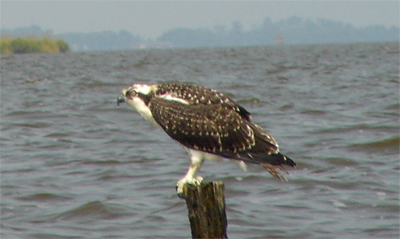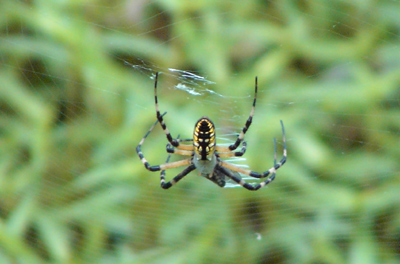On our first full day in the Outer Banks, we spent time at the beach to take stock of the various birds around us. Shorebirds were not as common as we would have expected, but we did see a few Semipalmated Sandpiper, Least Sandpiper, and Sanderling. The crows and grackles in the area were not the ones we were used to, but were instead predominantly Fish Crow and Boat-tailed Grackle respectively. The boat-tail, extremely common throughout the Outer Banks, was new for us. We also took a census of the various swallows that we’d been seeing. I’ll hazard that we spotted, at the very least, Bank Swallow, Barn Swallow, and Chimney Swift during our stay. This is a good time to point out that we are still awful at identifying birds. Our lists are far from thorough, so expect that for every two birds we list, there’s at least one we couldn’t ID.
You don’t need to be an expert birder to notice that Osprey rule OBX. The mighty fish eagle is a constant presence, either working the waves or flying overhead to show off the latest catch. At any given moment, a visitor to this area is probably within 100 yards of an Osprey nest. After a while, the sight of one of these awesome raptors diving feet-first into the ocean and emerging with a fat fish was almost (almost) mundane.

OBX Osprey
The last tatters of Hurricane Charley’s spent efforts made this a good day to relax indoors, so we watched the Olympics. As far as I’m concerned, these games make perfect viewing for a week at the beach. I expect that we will try to organize our vacation four years hence to coincide with the next Olympic competition.
The next morning, Mason got his first taste of swimming, but didn’t exactly love it. After the storm, the water in our pool was a bit too chilly. In the afternoon, Sara and I took Mason for a walk through the Currituck Banks Estuarine Reserve. Surrounded by 900 miles of water, the Outer Banks has the largest estuary system in the world. The Reserve features 960 acres of beach, dune, maritime forest and marsh, as well as a handsome boardwalk wending through some of the most fascinating habitat. The forest on the bay side of the island is absolutely beautiful. Somehow, though, when we walked through, there wasn’t a bird to be found. At least some interesting bugs made the scene:

Welcome to my web
The Estuarine Reserve is not far from the Currituck Beach Light, so we paid a visit to that towering structure. Actually, as far as lighthouses go, this one is pretty stubby, but it has a modest charm. Adjacent to the lighthouse is a structure that is anything but modest. The Whalehead Club was once a private residence for some wealthy residents of Corolla Island. This massive yellow mansion features art nouveau architecture, Tiffany lighting fixtures, corduroy walls and cork flooring, or so we are told. We were content to stroll the grounds of the Currituck Heritage Park. Adult and immature boat-tailed grackles dominated this area, but we did spot a few waders such as Spotted Sandpiper and Killdeer working the coast.
If I recall correctly, the rest of the day involved lots of beer.













I’m thinking of taking a trip from Washington, D.C. to the Outer Banks to go birding. I’m trying to decide the best place to go that won’t make the drive too much longer. Any thoughts?
Love your site! I enjoy photographing various bird species when I get the chance to get out and explore. You might enjoy some migratory bird photos from the historic Monkey Island in Corolla, NC that I’ve personally taken and posted to my website, obxstockphotos.com